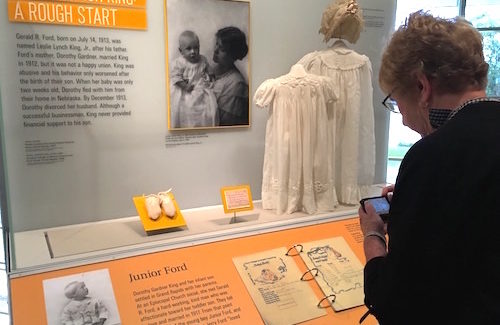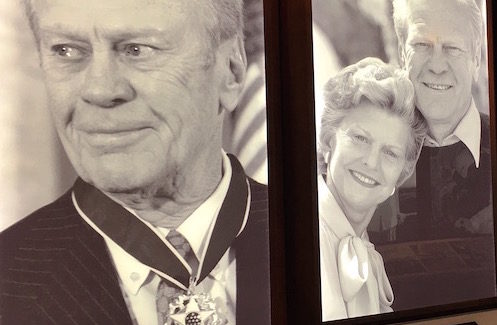Gerald Ford Presidential Museum Brings History to Life
The nation’s 38th president was born in Omaha in 1913 and named Leslie Lynch King Jr. If that name doesn’t ring a bell, it’s because his name was soon changed.
“Shortly after his birth, his mother moved to Grand Rapids. Following a divorce, his mother married a man named Gerald R. Ford,” said Kristin Mooney. “His mother then changed her son’s name to Gerald R. Ford Jr.”
That interesting tidbit, along with much more, is shared at the Gerald R. Ford Presidential Museum in Grand Rapids. Opened in 1981, the museum is organized in chronological order. The museum starts with Ford’s birth and ends with his death and legacy.
Both Gerald Ford and his wife Betty chose to be buried on museum grounds. Gerald died Dec. 26, 2006. Betty died July 8, 2011.
The museum is a treasure trove of personal items, old photographs, news clips, music, gifts, scholarly papers, tape recordings and interesting information. Instead of just showing history to visitors, the museum tries to put people right in the middle of it. The result is a conglomeration of sights and sounds that does a good job of taking visitors back in time to a decade when many museum visitors hadn’t even been born.
On display are the tiny booties the president wore as a baby, the lucky penny his wife Betty kept in her shoe at their wedding, the gun a Manson follower used in an assassination attempt on his life and the actual Saigon staircase used by thousands of people in the final days of the evacuation of Saigon in April 1975. People climbed to the roof of the American Embassy to escape aboard helicopters.
“Ford said it symbolizes ‘Man’s undying desire to be free,’” Mooney said. “President Ford said the people left behind in Saigon was his biggest failure.”
Champion athlete chooses political arena
Known as “Junior,” Ford was an outstanding athlete and an Eagle Scout. He was a good enough football player that he earned a scholarship at the University of Michigan in 1931. He was voted the team’s most valuable player in 1934.
Then Ford arrived at a crossroads. After college, Ford had a chance to play pro football. Instead, he entered Yale University and earned a law degree.
His career was put on hold when World War II broke out. Ford joined the U.S. Naval Reserve and served in the South Pacific aboard an aircraft carrier. Ironically, it wasn’t the enemy’s mortar that almost took his life — it was a force of nature. During a terrible typhoon in December 1944, Ford was almost swept overboard.
After the war, Ford returned to Grand Rapids and became a lawyer. He entered politics and was elected to Congress in 1948. He was re-elected 12 times. October of 1948 also saw Ford and Betty Bloomer become husband and wife.
Ford quickly climbed the political ladder. After Vice President Spiro Agnew resigned his office in late 1973, President Nixon chose Ford. Then the scandal escalated that cost Nixon his office and gave Ford his. At the museum, you can see the original tools used in the June 1972 Watergate break-in. A presentation traces the history of America’s notorious political scandal.
The result, of course, was that Congress charged Nixon in 1974 with obstruction of justice and misusing the power of his office. Nixon had a choice either to resign or be impeached.
On Aug. 9, 1974, Nixon resigned the presidency. At the same time, Vice President Ford was sworn in as the nation’s 38th president. One month later, Ford pardoned Nixon for “crimes he committed or may have committed.”
“President Ford gave the pardon so that the country could move on,” Mooney said. “He believed America needed to stop discussing Watergate and work on other problems at hand.”
But many Americans were angry about the pardon and that may be a prime reason why Ford wasn’t elected when his two years as Nixon’s replacement were up. Jimmy Carter beat him in the election.
Squeaky Fromme gun and letter to Ford
The museum itself could take hours to tour if you want to read, hear and see the multitude of materials presented. Some of the galleries bring back memories for anyone who lived the 1970s. Video and sound bites recall various news events, plus displays feature such 1970s memorabilia as platform shoes, tie-dyed garments, bell- bottom jeans, love beads, eight-track tapes and MIA bracelets.
A recreated Oval Office lets visitors feel as though they are peeking in on a day in Ford’s presidency. Another display spotlights First Lady Betty Ford and her battle with breast cancer.
“She was a very spunky lady which President Ford liked about her,” Mooney said. “Instead of keeping quiet about her breast cancer, she brought it to the forefront and talked about the disease, encouraging other women to get tested…She was probably ahead of her time because this was a time when First Ladies were just hostesses.”
Probably the most disturbing items on display can be easily overlooked. Mounted behind a glass frame is a .45 caliber pistol taken from Squeaky Fromme in her assassination attempt on Sept. 6, 1975. A little over two weeks later, Sara Jane Moore tried to kill the president in San Francisco.
On display is a letter Moore wrote to Ford from prison saying she was glad she didn’t kill the president because she has “an abhorrence of violence, particularly murder.”
Story and Photos by Jackie Sheckler Finch


















View Recent Comments